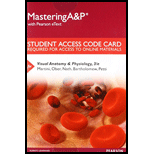
Masteringa&p With Pearson Etext -- Standalone Access Card -- For Fundamentals Of Anatomy & Physiology (11th Edition)
3rd Edition
ISBN: 9780134499710
Author: Martini, Frederic H., Nath, Judi L., Bartholomew, Edwin F.
Publisher: PEARSON
expand_more
expand_more
format_list_bulleted
Question
Chapter 18.1, Problem 4I
Summary Introduction
To explain: The blood vessel that is affected by the damage to the semilunar valve on the right side of the heart.
Introduction: The heart is a muscular organ. It pumps the blood all over the body through the circulatory system. It pumps deoxygenated blood to the lungs and oxygenated blood to the rest of the body. Thus, the human heart is called a dual pump. The heart and the blood vessels together constitute the cardiovascular system. The study of the heart is called cardiology.
Expert Solution & Answer
Want to see the full answer?
Check out a sample textbook solution
Students have asked these similar questions
State the location and function of Cardiac center.
Explain the changes in blood pressure and potentialthrombus formation.
Explain Congestive Heart Failure?
Chapter 18 Solutions
Masteringa&p With Pearson Etext -- Standalone Access Card -- For Fundamentals Of Anatomy & Physiology (11th Edition)
Ch. 18.1 - Prob. 1RCh. 18.1 - Prob. 2RCh. 18.1 - Prob. 3RCh. 18.1 - Prob. 4RCh. 18.1 - Prob. 5RCh. 18.1 - Prob. 6RCh. 18.1 - The anterior view of the heart is dominated by...Ch. 18.1 - Prob. 8RCh. 18.1 - Name and describe the shallow depressions and...Ch. 18.1 - Prob. 10R
Ch. 18.1 - Prob. 11RCh. 18.1 - Prob. 12RCh. 18.1 - Prob. 13RCh. 18.1 - Prob. 14RCh. 18.1 - Prob. 15RCh. 18.1 - Prob. 16RCh. 18.1 - Prob. 17RCh. 18.1 - Prob. 18RCh. 18.1 - Prob. 19RCh. 18.1 - Prob. 20RCh. 18.1 - Prob. 1LOCh. 18.1 - Prob. 2LOCh. 18.1 - Describe the structure of the pericardium and...Ch. 18.1 - Prob. 4LOCh. 18.1 - Describe the major vessels supplying the heart,...Ch. 18.1 - Prob. 6LOCh. 18.1 - Prob. 7LOCh. 18.1 - Prob. 8LOCh. 18.1 - Prob. 1ICh. 18.1 - Prob. 2ICh. 18.1 - C. Why is it important that cardiac tissue contain...Ch. 18.1 - Prob. 4ICh. 18.1 - Labeing: Label each of the structures in this...Ch. 18.1 - Prob. 2SRCh. 18.1 - Prob. 3SRCh. 18.1 - Prob. 4SRCh. 18.1 - Prob. 5SRCh. 18.1 - Prob. 6SRCh. 18.1 - Prob. 7SRCh. 18.1 - Prob. 8SRCh. 18.1 - Prob. 9SRCh. 18.1 - Prob. 10SRCh. 18.1 - Prob. 11SRCh. 18.1 - Prob. 12SRCh. 18.1 - Prob. 13SRCh. 18.1 - Prob. 14SRCh. 18.1 - Prob. 15SRCh. 18.1 - Prob. 16SRCh. 18.1 - Prob. 17SRCh. 18.1 - Prob. 18SRCh. 18.1 - Prob. 19SRCh. 18.1 - Prob. 20SRCh. 18.1 - Prob. 21SRCh. 18.1 - Prob. 22SRCh. 18.1 - Prob. 23SRCh. 18.1 - Prob. 24SRCh. 18.1 - Prob. 25SRCh. 18.1 - Prob. 26SRCh. 18.1 - Prob. 27SRCh. 18.1 - Prob. 28SRCh. 18.1 - Prob. 29SRCh. 18.1 - Prob. 30SRCh. 18.1 - Prob. 31SRCh. 18.1 - Prob. 32SRCh. 18.1 - Matching: Match each lettered term with the most...Ch. 18.1 - Prob. 34SRCh. 18.1 - Prob. 35SRCh. 18.2 - Prob. 1RCh. 18.2 - Prob. 2RCh. 18.2 - Prob. 3RCh. 18.2 - Prob. 4RCh. 18.2 - Why does tetany not occur in cardiac muscle?
Ch. 18.2 - Prob. 6RCh. 18.2 - Prob. 7RCh. 18.2 - Prob. 8RCh. 18.2 - Prob. 9RCh. 18.2 - Prob. 10RCh. 18.2 - Prob. 11RCh. 18.2 - Prob. 12RCh. 18.2 - Prob. 13RCh. 18.2 - Prob. 14RCh. 18.2 - Prob. 15RCh. 18.2 - Prob. 16RCh. 18.2 - Prob. 1LOCh. 18.2 - Prob. 2LOCh. 18.2 - Prob. 3LOCh. 18.2 - Prob. 4LOCh. 18.2 - Prob. 5LOCh. 18.2 - Describe the factors affecting the heart rate.
Ch. 18.2 - Prob. 7LOCh. 18.2 - Prob. 8LOCh. 18.2 - Prob. 1ICh. 18.2 - Prob. 2ICh. 18.2 - Prob. 3ICh. 18.2 - Prob. 4ICh. 18.2 - Prob. 5ICh. 18.2 - Prob. 1SRCh. 18.2 - Prob. 2SRCh. 18.2 - Prob. 3SRCh. 18.2 - Prob. 4SRCh. 18.2 - P wave
cardiac output
autorhythmicity
“lubb”...Ch. 18.2 - Prob. 6SRCh. 18.2 - Prob. 7SRCh. 18.2 - Prob. 8SRCh. 18.2 - Prob. 9SRCh. 18.2 - Prob. 10SRCh. 18.2 - Prob. 11SRCh. 18.2 - Prob. 12SRCh. 18.2 - Prob. 13SRCh. 18.2 - Prob. 14SRCh. 18.2 - Prob. 15SRCh. 18.2 - Prob. 16SRCh. 18.2 - Prob. 17SRCh. 18 - Prob. 1CRQCh. 18 - Prob. 2CRQCh. 18 - Prob. 3CRQCh. 18 - Prob. 4CRQCh. 18 - Prob. 5CRQCh. 18 - Prob. 6CRQCh. 18 - Prob. 7CRQCh. 18 - Prob. 8CRQCh. 18 - Prob. 9CRQCh. 18 - Prob. 10CRQCh. 18 - Prob. 11CRQCh. 18 - Prob. 12CRQCh. 18 - Prob. 13CRQCh. 18 - Prob. 14CRQCh. 18 - Prob. 15CRQCh. 18 - Prob. 16CRQCh. 18 - Prob. 17CRQCh. 18 - Prob. 18CRQCh. 18 - Prob. 19CRQCh. 18 - Prob. 20CRQCh. 18 - Prob. 1CICh. 18 - Prob. 2CICh. 18 - Prob. 3CI
Knowledge Booster
Learn more about
Need a deep-dive on the concept behind this application? Look no further. Learn more about this topic, biology and related others by exploring similar questions and additional content below.Similar questions
- (a) Describe how heart contraction and relaxation influence coronary blood flow. (b) Name the major branches of the coronary arteries, and note the heart regions served by each.arrow_forwardDiscuss the three classes of distributive shock and explain the difference in presentation of heart ratearrow_forward
Recommended textbooks for you
 Human Physiology: From Cells to Systems (MindTap ...BiologyISBN:9781285866932Author:Lauralee SherwoodPublisher:Cengage Learning
Human Physiology: From Cells to Systems (MindTap ...BiologyISBN:9781285866932Author:Lauralee SherwoodPublisher:Cengage Learning Medical Terminology for Health Professions, Spira...Health & NutritionISBN:9781305634350Author:Ann Ehrlich, Carol L. Schroeder, Laura Ehrlich, Katrina A. SchroederPublisher:Cengage Learning
Medical Terminology for Health Professions, Spira...Health & NutritionISBN:9781305634350Author:Ann Ehrlich, Carol L. Schroeder, Laura Ehrlich, Katrina A. SchroederPublisher:Cengage Learning

Human Physiology: From Cells to Systems (MindTap ...
Biology
ISBN:9781285866932
Author:Lauralee Sherwood
Publisher:Cengage Learning

Medical Terminology for Health Professions, Spira...
Health & Nutrition
ISBN:9781305634350
Author:Ann Ehrlich, Carol L. Schroeder, Laura Ehrlich, Katrina A. Schroeder
Publisher:Cengage Learning
Complications during Labour and Delivery; Author: FirstCry Parenting;https://www.youtube.com/watch?v=QnCviG4GpYg;License: Standard YouTube License, CC-BY